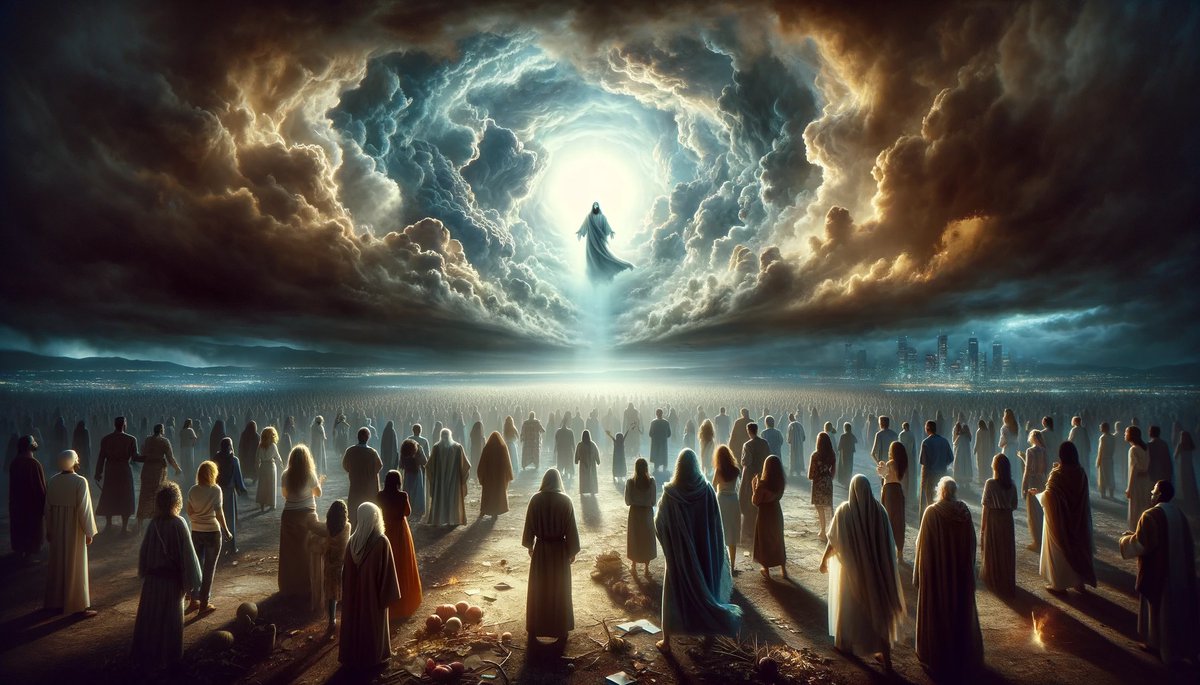Home>Christian Videos>Bible Stories>How Long After The Anti-christ Is Revealed Will Jesus Come?


Bible Stories
How Long After The Anti-christ Is Revealed Will Jesus Come?
Published: March 3, 2024
Peter Smith, Editorial Director at Christian.net, combines deep insights into faith, politics, and culture to lead content creation that resonates widely. Awarded for his contributions to religious discourse, he previously headed a major organization for religious communicators, enhancing dialogue on faith's societal impacts.
Discover the timeline of events in the Bible, including the revelation of the Antichrist and the return of Jesus. Explore the prophetic significance and timing of these pivotal moments.
(Many of the links in this article redirect to a specific reviewed product. Your purchase of these products through affiliate links helps to generate commission for Christian.net, at no extra cost. Learn more)
Table of Contents
The Significance of the Anti-Christ's Revelation
The revelation of the Anti-Christ holds immense significance in Christian eschatology. It is believed to be a pivotal event signaling the beginning of the end times and the imminent return of Jesus Christ. The Anti-Christ is often depicted as a figure of great deception and evil, who will deceive many and lead them away from the true faith. This figure is mentioned in the New Testament, particularly in the books of Daniel, 2 Thessalonians, and Revelation, and is associated with the rise of a global system of governance that opposes God and persecutes believers. The revelation of the Anti-Christ is a critical precursor to the events leading up to the Second Coming of Jesus, and it serves as a warning to believers to remain steadfast in their faith and to be vigilant in discerning the signs of the times.
The Anti-Christ as a Symbol of Spiritual Warfare
The revelation of the Anti-Christ symbolizes the intensification of spiritual warfare between the forces of good and evil. In Christian theology, the Anti-Christ is seen as the ultimate adversary of Christ, seeking to undermine His redemptive work and establish a counterfeit kingdom. This spiritual conflict is not merely a physical battle but a cosmic struggle for the souls of humanity. The Anti-Christ's revelation serves as a stark reminder of the ongoing spiritual warfare and the need for believers to equip themselves with the armor of God, as mentioned in the book of Ephesians, to withstand the schemes of the devil.
A Warning Against Deception and Apostasy
The Anti-Christ's revelation also serves as a warning against deception and apostasy in the last days. The New Testament scriptures caution believers about the rise of false prophets, false teachings, and deceptive signs and wonders that will lead many astray. The Anti-Christ embodies the epitome of deception, presenting himself as a savior while promoting doctrines contrary to the truth of the Gospel. The significance of the Anti-Christ's revelation lies in its role as a cautionary sign, prompting believers to hold fast to the genuine teachings of Christ and to discern the spirits, as instructed in the first epistle of John.
Anticipation of the Ultimate Triumph of Christ
Furthermore, the revelation of the Anti-Christ engenders a sense of anticipation for the ultimate triumph of Christ and the establishment of His eternal kingdom. While the Anti-Christ may wield temporary power and authority, his reign is ultimately destined to be overthrown by the victorious return of Jesus Christ. The significance of the Anti-Christ's revelation lies in its role as a precursor to the fulfillment of God's sovereign plan, culminating in the restoration of all things under the lordship of Christ. This anticipation serves to encourage believers to persevere in hope and to fix their eyes on the glorious return of the true King, who will reign in righteousness and justice.
In summary, the revelation of the Anti-Christ holds profound significance in Christian eschatology, serving as a symbol of spiritual warfare, a warning against deception and apostasy, and a source of anticipation for the ultimate triumph of Christ. It underscores the need for believers to remain steadfast in their faith, to discern the signs of the times, and to eagerly await the return of Jesus Christ.
Understanding the Timing of Jesus' Second Coming
The timing of Jesus' second coming has been a subject of great interest and speculation throughout the history of Christianity. While the exact timing remains unknown, the Bible provides insights and indicators that help believers understand the general season and signs preceding this monumental event.
1. Imminence and Vigilance
The New Testament emphasizes the imminence of Jesus' return, urging believers to be vigilant and ready at all times. The parables of the wise and foolish virgins and the unexpected thief in the night illustrate the need for constant readiness, as the Son of Man will come at an hour when people do not expect him. This underscores the unpredictability of the timing and the necessity for believers to live in a state of preparedness.
2. Signs of the Times
Jesus and the apostles provided various signs and events that would precede the second coming. These include wars and rumors of wars, natural disasters, the rise of false prophets, persecution of believers, and the widespread preaching of the gospel to all nations. While these signs serve as indicators of the approaching end times, they also remind believers to interpret the times and to discern the fulfillment of these prophecies in their contemporary context.
3. The Revelation of the Anti-Christ
The revelation of the Anti-Christ is a significant event that precedes the second coming of Jesus. The emergence of this deceptive figure, as foretold in the scriptures, marks a critical phase in the eschatological timeline. The Anti-Christ's rise to power, accompanied by his blasphemous actions and persecution of believers, serves as a clear sign of the approaching climax of human history and the impending return of Christ to establish His kingdom.
4. God's Sovereign Timing
Ultimately, the timing of Jesus' second coming is under the sovereign control of God. The scriptures affirm that no one knows the day or the hour, not even the Son, but only the Father. This divine mystery underscores the trust and reliance of believers on God's perfect timing, while also emphasizing the need for watchfulness and faithful stewardship of the time and resources entrusted to them.
5. The Call to Endurance and Hope
While the exact timing of Jesus' return remains undisclosed, believers are called to endurance and hope in the midst of uncertainty. The apostle Paul encourages the Thessalonian believers to stand firm and to encourage one another with the hope of the resurrection and the glorious return of Christ. This enduring hope serves as an anchor for the soul, sustaining believers through trials and tribulations as they eagerly await the blessed hope of the appearing of the great God and Savior, Jesus Christ.
In summary, understanding the timing of Jesus' second coming involves embracing the imminence of His return, discerning the signs of the times, recognizing the significance of the revelation of the Anti-Christ, acknowledging God's sovereign timing, and maintaining endurance and hope in anticipation of the glorious event. While the precise day and hour remain unknown, the scriptures provide a framework for believers to live in readiness and expectation of the triumphant return of their Lord and Savior, Jesus Christ.
Biblical Prophecies Related to the Anti-Christ and Jesus' Return
-
The Book of Daniel: The book of Daniel in the Old Testament contains prophecies that are often associated with the Anti-Christ and the end times. In Daniel 7, there is a vision of four great beasts, representing four powerful kingdoms, and a final beast with ten horns, symbolizing a future oppressive ruler. This ruler is described as speaking boastfully and waging war against the saints. The book also speaks of a time of great distress, during which the people of God will be persecuted, followed by the ultimate triumph of the Son of Man, who will receive an everlasting kingdom.
-
The Book of Revelation: The book of Revelation, attributed to the apostle John, is rich in apocalyptic imagery and prophecies concerning the Anti-Christ and the return of Jesus Christ. In Revelation 13, the vision of a beast rising out of the sea, possessing blasphemous authority and demanding worship, is often interpreted as a representation of the Anti-Christ. This figure is accompanied by another beast, often referred to as the False Prophet, who performs miraculous signs and deceives the inhabitants of the earth. The book also depicts the cosmic battle between the forces of evil and the triumphant return of Jesus Christ, who ultimately defeats the Anti-Christ and establishes His reign of righteousness.
-
The Olivet Discourse: In the synoptic Gospels of Matthew, Mark, and Luke, Jesus delivers the Olivet Discourse, in which He speaks about the signs of the end times and His second coming. He warns of false messiahs, wars, famines, earthquakes, and persecution, and describes the tribulation that will precede His return. Jesus also alludes to the "abomination of desolation," a significant event related to the Anti-Christ, as prophesied in the book of Daniel. He concludes with the promise of His glorious return, accompanied by cosmic signs and the gathering of His elect from the four winds.
-
The Man of Lawlessness: The apostle Paul, in his second epistle to the Thessalonians, provides insights into the rise of the Anti-Christ and the events preceding the day of the Lord. He speaks of the "man of lawlessness" who will exalt himself above every so-called god and set himself up in God's temple, proclaiming himself to be God. This figure is described as the embodiment of deception and lawlessness, whose coming is in accordance with the work of Satan. Paul emphasizes the necessity of discerning the signs of the times and standing firm in the truth of the Gospel amidst the rise of such deceptive forces.
-
The Restoration of Israel: The prophets of the Old Testament, including Ezekiel, Jeremiah, and Zechariah, foretold the restoration of Israel and the gathering of the nations against Jerusalem in the last days. These prophecies are often intertwined with the rise of the Anti-Christ and the ultimate vindication and deliverance of God's people by the victorious return of Jesus Christ. The restoration of Israel and the fulfillment of God's covenant with His chosen people are integral components of the eschatological prophecies related to the Anti-Christ and Jesus' return.
In summary, biblical prophecies related to the Anti-Christ and Jesus' return are intricately woven throughout the Old and New Testaments, providing a tapestry of apocalyptic visions, symbolic imagery, and prophetic insights into the culmination of human history. These prophecies serve to alert believers to the signs of the times, to prepare them for the challenges of the end times, and to instill in them a steadfast hope in the ultimate victory and reign of Jesus Christ.
Interpreting the Signs of the End Times
The signs of the end times, as outlined in the scriptures, serve as crucial indicators for believers to discern the unfolding of eschatological events and to understand the imminent return of Jesus Christ. These signs encompass a wide array of phenomena, both in the natural and spiritual realms, that collectively point to the culmination of human history and the establishment of God's eternal kingdom.
-
Wars and Rumors of Wars: Jesus, in His discourse on the Mount of Olives, forewarned of wars and rumors of wars as precursors to the end times. The prevalence of armed conflicts, geopolitical tensions, and the escalation of warfare in various regions of the world serves as a poignant sign of the approaching climax of human history.
-
Natural Disasters and Cosmic Disturbances: The scriptures speak of earthquakes, famines, and pestilences as signs of the end times. The increasing frequency and intensity of natural disasters, coupled with celestial phenomena such as blood moons and solar eclipses, underscore the cosmic upheaval preceding the return of Jesus Christ.
-
Persecution and Apostasy: The rise of persecution against believers and the widespread apostasy within the church are prophesied as significant signs of the end times. The scriptures caution about the increase of lawlessness, the betrayal of fellow believers, and the distortion of sound doctrine, all of which serve as poignant warnings for believers to remain steadfast in their faith.
-
Global Unrest and Moral Decay: The moral decay and societal upheaval witnessed in contemporary times align with the biblical prophecies concerning the end times. The prevalence of immorality, greed, arrogance, and the rejection of God's truth mirror the prophesied conditions preceding the return of Jesus Christ.
-
The Restoration of Israel and the Preaching of the Gospel: The restoration of Israel as a nation and the widespread preaching of the gospel to all nations are pivotal signs of the end times. The fulfillment of these prophecies underscores the unfolding of God's redemptive plan and the imminent return of Jesus Christ to establish His reign.
-
The Revelation of the Anti-Christ: The emergence of the Anti-Christ, as foretold in the scriptures, is a definitive sign of the end times. This deceptive figure, accompanied by false signs and wonders, seeks to deceive many and establish a global system of governance in opposition to God, heralding the approaching climax of human history.
Interpreting these signs of the end times requires discernment, wisdom, and a deep understanding of the prophetic scriptures. While these signs may evoke fear and uncertainty in the hearts of many, they also serve to fortify the faith of believers, reminding them of the certainty of God's promises and the imminent return of Jesus Christ. As such, believers are called to interpret these signs with spiritual insight, to remain watchful and prayerful, and to proclaim the hope of the gospel amidst the prevailing signs of the end times.
The Role of the Anti-Christ in Eschatology
The Anti-Christ plays a pivotal role in eschatology, the theological study of the end times and the ultimate destiny of humanity. As a central figure in apocalyptic literature and Christian prophecy, the Anti-Christ embodies the epitome of deception, rebellion against God, and the culmination of evil forces in the last days. The scriptures provide profound insights into the multifaceted role of the Anti-Christ in the eschatological narrative, shedding light on his rise to power, his blasphemous actions, and his ultimate defeat at the triumphant return of Jesus Christ.
1. The Deceptive Leader
The Anti-Christ is depicted as a charismatic and deceptive leader who rises to prominence on the world stage, wielding great political, economic, and religious influence. His charismatic persona and persuasive rhetoric enable him to garner widespread support and allegiance, leading many astray with his false promises and deceptive agenda. The scriptures warn of his ability to perform miraculous signs and wonders, further deceiving the inhabitants of the earth and establishing a counterfeit authority that opposes the sovereignty of God.
2. The Persecutor of Believers
In addition to his deceptive nature, the Anti-Christ is characterized as a persecutor of believers and a fierce opponent of the true faith. His reign is marked by intense persecution, oppression, and hostility towards those who remain faithful to the teachings of Jesus Christ. The scriptures foretell a time of great tribulation, during which the Anti-Christ, in alliance with the false prophet, institutes a global system of governance that seeks to eradicate the worship of the true God and to suppress the testimony of Jesus' followers.
3. The Blasphemous Adversary
The Anti-Christ's blasphemous actions and arrogant defiance against God are central to his role in eschatology. He exalts himself above all that is called God, proclaiming himself to be divine and demanding worship from the inhabitants of the earth. His blasphemous assertions and desecration of sacred truths serve as a direct affront to the sovereignty and lordship of God, culminating in a climactic confrontation between the forces of good and evil.
4. The Catalyst for the Final Conflict
The emergence of the Anti-Christ serves as a catalyst for the final cosmic conflict between the forces of darkness and the triumphant return of Jesus Christ. His rise to power and the establishment of a global dominion precipitate a time of unparalleled upheaval and spiritual warfare, setting the stage for the ultimate confrontation between the Anti-Christ and the returning King of Kings. This climactic conflict, as depicted in apocalyptic literature, culminates in the defeat of the Anti-Christ and the establishment of God's eternal kingdom.
5. The Defeat and Judgment
Ultimately, the role of the Anti-Christ in eschatology leads to his definitive defeat and judgment at the hands of Jesus Christ. The scriptures vividly portray the downfall of the Anti-Christ, his false prophet, and the spiritual forces aligned with them, as they are vanquished by the glorious return of Jesus. This decisive victory heralds the restoration of all things, the vindication of the saints, and the establishment of a new heaven and a new earth, free from the influence of evil and deception.
In summary, the role of the Anti-Christ in eschatology encompasses his deceptive leadership, persecution of believers, blasphemous defiance against God, catalytic role in the final conflict, and ultimate defeat and judgment. His emergence and subsequent downfall serve as integral components of the eschatological narrative, underscoring the sovereignty of God, the triumph of righteousness, and the fulfillment of God's redemptive plan for humanity.











